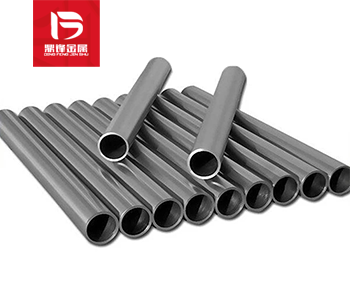
Palladium Tube Recycling
A tube made of metallic palladium is called a palladium tube (palladium alloy tube), and the size of the palladium tube used is mostly φ 20.08mm, can be used for the separation of hydrogen and impurities. The principle of palladium tube purification of hydrogen is that at 300-500 ℃, when the hydrogen to be purified is introduced to the other side of the palladium tube, the hydrogen is chemically adhered to the wall of the palladium tube and dissociated into hydrogen atoms. The hydrogen atoms and palladium atoms form alloy type hydrides, and the hydrogen atoms occupy the gap edges in the metal lattice, also known as interstitial hydrides. Under the promotion of concentration gradient, hydrogen atoms can spread through the walls of palladium tubes, forming a hydrogen molecular color layer again after passing through the tubes.
- Parameter
- Related Questions and Answers
-
Name : Palladium Tube
-
Use : Hydrogen separation and purification,Catalysts and chemical reactors
-
Application Areas : Hydrogen separation, catalysis, sensors, aerospace, medicine
-
Appearance and properties : Silver tube
-
Settlement Method : On site payment
-
Recycling Type : Palladium recycling
-
Door-to-door recycling:worldwide
-
Customer service: Free content testing and door-to-door recycling
Palladium Graphite Recycling
Palladium graphite is a composite material composed of palladium (Pd) and graphite. Specific forms may include:
Palladium nanoparticles distributed in a graphite matrix
Palladium-graphite alloy or catalyst coating
Palladium graphite is a material composed of palladium (Pd) nanoparticles and graphene (or graphene oxide). Its typical structure includes palladium nanoparticles uniformly loaded on graphene sheets, or combined with magnetic materials (such as Fe₃O₄) to form a ternary composite material (such as Pd-Fe₃O₄/reduced graphene oxide nanocomposite). This structure combines the high catalytic activity of palladium with the high specific surface area, conductivity and stability of graphene, while the addition of magnetic components (such as Fe₃O₄) can realize the magnetic recovery properties of the material.
Waste Palladium Carbon Recycling
Palladium on Carbon (Pd/C) is a supported palladium catalyst in which palladium metal is loaded onto high-surface-area activated carbon. It appears as a black or dark gray powder and is widely used in organic synthesis, pharmaceuticals, petrochemicals, and environmental protection. Pd/C is known for its high catalytic efficiency, stability, and recoverability, making it an essential catalyst in various industries.
Search : Waste Palladium Carbon RecyclingPalladium Catalysts Recycling
A palladium catalyst is a chemical catalyst that uses palladium (Pd) as its active component, typically supported on materials such as alumina, activated carbon, silica, or zeolite. It is widely used in various industries due to its excellent catalytic properties.Recycling methods include acid leaching, solvent extraction, high-temperature smelting, and electrolysis, which allow for the recovery and refining of palladium to a purity of 99.95% or higher.
Search : Palladium Catalysts RecyclingPalladium(II) Iodide Recycling
Palladium(II) iodide is a versatile palladium catalyst with a black floc appearance, known for its applications across various industries including pharmaceuticals, laboratories, petroleum, food, new energy, and military. Its role as a catalyst is crucial for speeding up reactions, such as drug synthesis, enzyme reactions, and fuel cell processes.
Search : Palladium(II) Iodide RecyclingProduct Details
A tube made of metallic palladium is called a palladium tube (palladium alloy tube), and the size of the palladium tube used is mostly φ 20.08mm, can be used for the separation of hydrogen and impurities. The principle of palladium tube purification of hydrogen is that at 300-500 ℃, when the hydrogen to be purified is introduced to the other side of the palladium tube, the hydrogen is chemically adhered to the wall of the palladium tube and dissociated into hydrogen atoms. The hydrogen atoms and palladium atoms form alloy type hydrides, and the hydrogen atoms occupy the gap edges in the metal lattice, also known as interstitial hydrides. Under the promotion of concentration gradient, hydrogen atoms can spread through the walls of palladium tubes, forming a hydrogen molecular color layer again after passing through the tubes. Therefore, palladium tubes can be used to obtain high-purity hydrogen. Although palladium has unique borrowing properties for hydrogen, pure palladium has poor mechanical properties, is prone to hydrolysis at high temperatures, and has low recrystallization temperature, which can easily cause deformation and embrittlement of palladium tubes. Therefore, pure palladium cannot be used as a borrowing membrane. Embedding moderate IB and VIII group elements into palladium to make palladium alloys can improve the mechanical properties of palladium. In the application field of palladium alloys, silver accounts for about 20-30%, and the content of other components (such as gold) is< 5%. The rate of hydrogen borrowing from palladium alloy is related to temperature, membrane thickness, and the pressure difference (△ P) between the raw hydrogen and pure hydrogen on both sides of the diffusion zone. Increasing the temperature, reducing △ P, and decreasing the thickness of the membrane will reduce the hydrogen permeation rate. But an increase in temperature will reduce the tensile strength of the spreading film. Therefore, the temperature used for palladium tubes is generally controlled below 450 ℃. Some impurities can cause palladium poisoning, improve breathability, and damage the membrane. The substances that can cause palladium poisoning include mercury, Arsenide, halide, oil vapor, sulfur and ammonia containing substances and dust. Waste palladium tubes are one of the sources of palladium containing waste recycling, including palladium recovery, colloidal palladium recovery, palladium wire recovery, palladium particle recovery, palladium salt recovery, palladium alloy recovery, etc. If you have any demand for palladium containing waste recycling, please call our 24-hour service hotline. Dingfeng Precious Metal Recycling and Refining Factory has independent recycling and refining factories without intermediaries to earn price differences. Our professional technical team and customer service personnel provide one-on-one services to ensure customer privacy during the recycling process.

